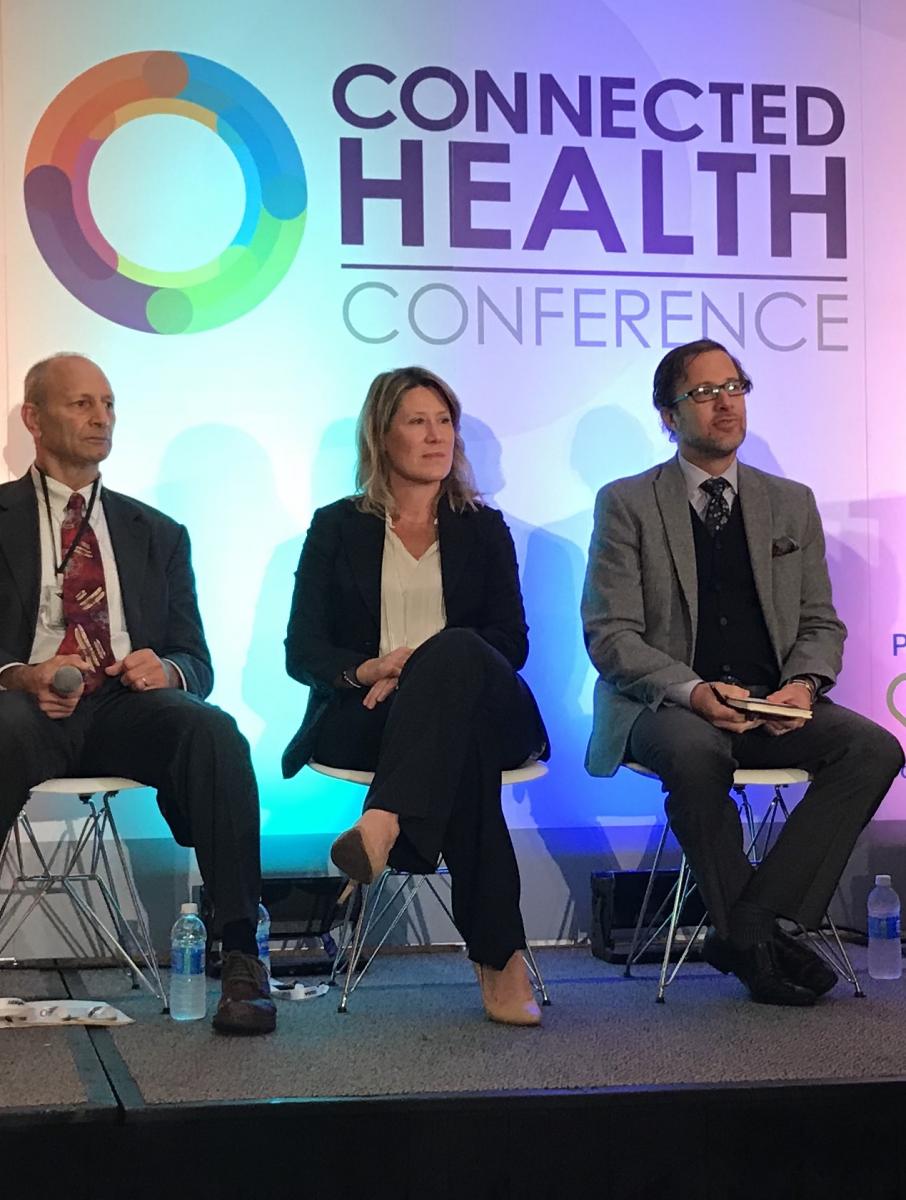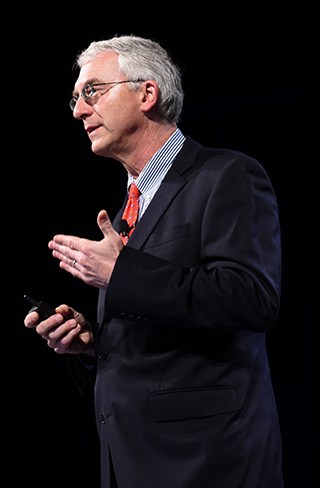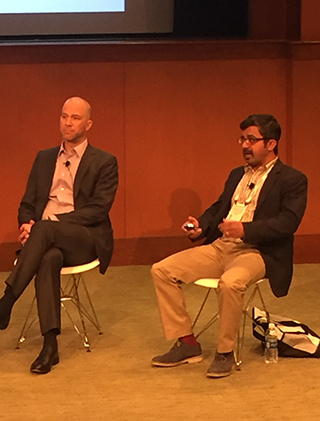Share this
With careful design, seniors can find solace in new tech
by Rendever on Nov 3, 2017 2:40:00 PM
We recently had the pleasure of presenting at the Connected Health Conference in Boston, MA, where our cofounder and CEO Kyle Rand had the pleasure of being a part of two separate presentations. He presented on Rendever as a whole, and served on a panel alongside members from Hasbro, Catalia Health, and UPenn. Some of his thoughts were featured alongside members from AARP and Partners Healthcare. Read below, or find the full article here.
With careful design, seniors can find solace in new tech
Aging care was a frequent topic among the panels and sessions hosted at last week’s Connected Healthcare Conference in Boston. Amidst conversations on remote care, new technology adoption, and other issues of wellness affecting seniors, speakers argued again and again that thoughtfully designed technologies will increasingly be needed to address a patient group that shows no signs of shrinking.
“By 2020, the ratio will be 3:1 — three people needing care, one person to provide it. Those are really scary stats that are only going to get worse,” Anne Marie Paterno Kilgallon, VP of enterprise strategy and innovation at the AARP, said during a session. “We have to talk about how do we take care of people as they age, how does technology help us as we age? That is the unique identifier across all of this, technology. Everybody’s situation is unique and individual, but technology lets us make it personalized.”

Both Paterno Kilgallon and Dr. Joseph Kvedar, vice president, Connected Health, Partners Healthcare, stressed to audience members that without innovation, the health care system’s capacity for aging care will be outstripped by the demands of a population whose life expectancy is extending every year. New health technologies not only be required to extend care to more patients, but will also need to better connect with seniors and solve unmet issues that are increasingly becoming a burden on the system at large.
“We’re not getting any younger, either individually or as a society. In fact, for the first time in history, by 2020 there’ll be more people over 65 than under five,” Kvedar said during his keynote presentation. “Every time we do care delivery … we’re doing it one-to-one. You’re all really bright people, you can do the math. We’re going to run out of people to deliver care if we don’t think about doing it differently.”
Debunking the myth of technophobia
The demand for new health technologies is clear, but placing these innovations in the hands of seniors often sparks a discussion that many in the industry feel has been blown out of proportion.
“There’s this huge stereotype that seniors and tech just don’t mix, and it’s perpetuated by a lot of unfortunate technologies,” Kyle Rand, cofounder of senior-focused virtual reality company Rendever, said during a panel. “Think about printers. I have my parents calling me asking me about how to use the printer every other week.”
During his talk Kvedar argued that, on the larger scale, culture’s assumptions regarding the seniors’ technological literacy are widely blown out of proportion. Specifically, he pointed to the increased adoption of consumer fitness wearables and social media as indicators of the aging population’s willingness to embrace new ideas and technologies. Over the course of the conference, these points generally saw support from entrepreneurs’ first hand accounts of introducing new technologies to seniors.

“If we have a session where we’re showing different capabilities, at some point we have to stop to remind people that they’re talking to a computer because that realization doesn’t enter their heads,” Andy Kropa, founder of SoundMind, a senior-focused voice platform, said during a panel. “There’s a theory that people won’t like it or won’t understand it, or they’ll be creeped out by the voice or something like that, but that’s not happened at all. It’s been the opposite of that experience.”
Nathan Treloar, president and chief operating officer of voice technology company Orbita, offered a similar response.
“I think we all have seen this, a remarkable level of interest in adoption among a community of older people who you would think would be more technophobic,” he said. “There is sort of a natural learning curve for some of these voice applications, but my experience has been quite contrary to my initial expectations that older people would be less likely to use this technology.”
In many cases, Rand explained, the root of the problem isn’t that seniors are incapable of operating new technologies, but that the interfaces they’re given are inherently unwieldy. Pointing to his own company’s experience in creating a VR product, Rand said that the first step should often be directed efforts toward lowering the barrier of entry.
“When I first put on a [VR] headset, I found the interface really, really frustrating. It’s virtual, you don’t actually see your hands, so you’re interacting with it with your eyes. It’s very counter-intuitive,” Rand said. “So, we spent a lot of time creating a lot of background services that allow a resident in a VR headset to enjoy virtual reality, without really learning how to use virtual reality. That’s really, really important. When you think about what your user population is, you know there are a whole realm of assisted devices and assisted concepts. You have to apply those to the new tech you’re deploying.”
Senior-minded interface design is well understood among the healthy number of voice-powered services that have sprung up over the last few years. Anne Weiler, CEO and cofounder of Wellpepper, said that her team has encountered its fair share of unexpected complications when working with the technology.
“We’ve seen the assumption that ‘Hey that will be totally fine for seniors,’ but then found in our testing that maybe for someone who’s hard of hearing we needed [the voice interface to be] slower and louder,” she said. “So that’s a request for you guys [in the audience] because, while a developer can put pauses into an application, it would be really good for an end user to be able to set the speed so you can build one application for any age group and have them adjust.”
S. Shyam Sundar, professor and founder of the Media Effects Research Laboratory at Pennsylvania State University, has been researching technology adoption and perceptions among the aging population for roughly a decade. Looking back on his research, he explained that there are often more complex factors at play than simply whether or not an individual is open minded.
“[For example,] we found that there are some good reasons for them to join Facebook. Some of them have adopted it heartily, but several others haven’t,” he said during a panel. “Privacy is a big concern, but on the other hand surveilling your family and friends is something that they love to do. They don’t care about the privacy of others, but care too much about the privacy of themselves in a way, so there are these contradicting and very nuanced underlying psychologies among older adults in the adoption of social networking sites.”

Sundar and his research team found multilayered reactions to seniors’ receptions of other technologies as well. Speaking on care-focused robots, such as Catalia Health’s Mabu, said that the elderly are generally receptive, but pointed to “robot army” tropes prominent in popular fiction and movies as a clear driver of distrust. Moving forward, he suggested that those developing new robots or similar technologies for seniors take special care when designing their personalities.
“All kinds of expressions matter, non-verbals matter, demeanor matters,” Sundar said. “We found some interesting results. We thought if a robot is a companion it should have a cheery demeanor, and if it’s an assistant robot it should be more serious. But we actually found the reverse — we found if it’s too cheery it feels very uncannily human, an Uncanny Valley Effect.”
That being said, innovators shouldn’t completely shy away from realism when developing VR, robots, or any other technologies for seniors. Sundar made a point to explain to the audience and the other panel members that the more believable an abstract or unfamiliar technology is, the more appealing it is to the brain, a rule of thumb that is of increased importance when building for more wary seniors.
“There is in fact such a thing as realism heuristic, which is very similar to the idea that seeing is believing,” he said. “When people feel that this is real, there is an instinctive reaction that this is credible, so … you want it to be as real as possible.”
Novel designs address isolation
Across the conference’s sessions on aging care technologies, a number of speakers highlighted seniors’ mental wellness as a substantial issue in need of address. Specifically, they stressed how social isolation, loneliness, and other related mental health problems can have a clear impact on medical outcomes and quality of life.
“Social isolation is a big issue in this space. There’s not enough innovation,” Rand said. “When you think about social isolation within communities, there’s this strong, strong correlation between social isolation, depression, and dementia.”
Rand said that his company views shared experiences as the cornerstone of human relationships, and sees VR as a tool to build connections between senior care center residents. More specifically, he said Rendever has found success in creating VR vacation scenarios that users can explore alongside their peers, thereby allowing residents to discuss the virtual trips they shared together.
Dr. Sonya Kim, founder and CEO of the senior outreach and emotional treatment company One Caring Team, echoed Rand’s points on the medical (and financial) costs of seniors’ isolation. More so, she stressed how new technologies such as VR can ameliorate isolation and other mental health issues by, almost literally, transporting users to new surroundings.
“You’re not looking at the brutal reality of loneliness and the nursing homes and your depressed outlook on life,” she said. “You’re transported immediately to Hawaii, Paradise Island, whatever. That’s what we mean by power of presence, and transporting seniors to a happy place.”
 But not all efforts to reduce seniors’ isolation have to be quite as high-concept as VR, Ted Fischer, vice president of business development at Hasbro, suggests. Over the past few years, the toy manufacturer has introduced to consumers a line of animatronic cats and dogs specifically designed to act as a companion for aging loved ones. These devices may not be a perfect simulation of the pets they’re replicating, but they are immediately recognizable and offer lonely seniors a real-world outlet for natural feelings of compassion and nurturing.
But not all efforts to reduce seniors’ isolation have to be quite as high-concept as VR, Ted Fischer, vice president of business development at Hasbro, suggests. Over the past few years, the toy manufacturer has introduced to consumers a line of animatronic cats and dogs specifically designed to act as a companion for aging loved ones. These devices may not be a perfect simulation of the pets they’re replicating, but they are immediately recognizable and offer lonely seniors a real-world outlet for natural feelings of compassion and nurturing.
“Innovation doesn’t always have to be bleeding edge,” Fischer said. “This is pretty simple stuff that’s having an impact.”
Simulation-based solutions such as these as well as other recent technologies — notably social media — can offer isolated members of the aging population key support that can extend lives and provide a sense of purpose, Kvedar mentioned. However, such implementations will always need to be thoughtfully designed, and should never serve as the entirety of one’s social and interpersonal interactions.
“That’s a bad use of any of these technologies,” he said. “But, when you can’t be with your loved one because you have a life, and in a care facility when you just can’t have enough people to get around, if these things are thoughtfully designed and brought in they will be able to drive home that connected care feeling that individuals will need when they get older. We have to design that right.”
Share this
- Uncategorized (43)
- virtual reality (20)
- VR (18)
- agetech (17)
- resident engagement (17)
- seniors (16)
- activity professionals (10)
- senior living technology (9)
- VirtualReality (7)
- RendeverLive (6)
- aging tech (6)
- Expanding Worlds (5)
- older adults (5)
- Press Release (3)
- assisted living (3)
- hospice (3)
- special events (3)
- TimeBestInventions (2)
- bucket list (2)
- mental health (2)
- sales (2)
- social isolation (2)
- GameDev (1)
- LeadingAge (1)
- NewHire (1)
- OpenSource (1)
- PalmsatLaQuinta (1)
- StephanieStallings (1)
- TiltBrush (1)
- alcove (1)
- ces (1)
- family (1)
- multibrush (1)
- research (1)
- October 2025 (1)
- September 2025 (1)
- August 2025 (1)
- July 2025 (3)
- June 2025 (2)
- May 2025 (5)
- April 2025 (3)
- March 2025 (3)
- February 2025 (2)
- January 2025 (2)
- December 2024 (2)
- November 2024 (4)
- October 2024 (1)
- August 2024 (1)
- July 2024 (1)
- May 2024 (1)
- January 2024 (1)
- December 2023 (1)
- September 2023 (1)
- April 2023 (2)
- February 2023 (2)
- January 2023 (7)
- December 2022 (1)
- November 2022 (3)
- October 2022 (2)
- August 2022 (1)
- July 2022 (1)
- June 2022 (2)
- May 2022 (1)
- April 2022 (2)
- March 2022 (2)
- February 2022 (1)
- January 2022 (6)
- December 2021 (1)
- November 2021 (3)
- October 2021 (1)
- September 2021 (2)
- August 2021 (1)
- April 2021 (2)
- March 2021 (4)
- February 2021 (3)
- January 2021 (6)
- November 2020 (1)
- October 2020 (2)
- August 2020 (2)
- July 2020 (2)
- June 2020 (1)
- March 2020 (4)
- October 2019 (1)
- August 2019 (2)
- July 2019 (1)
- March 2019 (1)
- December 2018 (1)
- August 2018 (1)
- July 2018 (2)
- June 2018 (3)
- April 2018 (1)
- December 2017 (2)
- November 2017 (1)
- October 2017 (2)
- September 2017 (1)
- August 2017 (1)
- July 2017 (1)
No Comments Yet
Let us know what you think